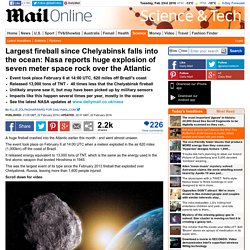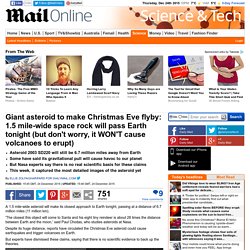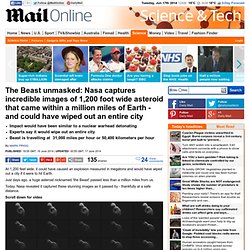

'Huge' meteor soaring across the night sky above Maine is captured by a cop' Police Sgt.

Tim Farris was watching for speeders in Portland, MaineHis dash cam captured a fire ball in the sky around 12:50 a.m. EDTFireball likely a stray meteor burning up entering the Earth's atmospherePrimarily seen in Maine, it was also visible from Vermont, New Hampshire, New Jersey, Massachusetts, New York, Rhode Island, Pennsylvania, Connecticut, Ontario, and Quebec. Lyrid meteor shower 2016: When can stargazers see the annual show? Nasa reports largest fireball since Chelyabinsk falls into Earth. A huge fireball crashed into the Atlantic earlier this month - and went almost unseen.

The event took place on February 6 at 14:00 UTC when a meteor exploded in the air 620 miles (1,000km) off the coast of Brazil. It released energy equivalent to 13,000 tons of TNT, which is the same as the energy used in the first atomic weapon that leveled Hiroshima in 1945. This was the largest event of its type since the February 2013 fireball that exploded over Chelyabinsk, Russia, leaving more than 1,600 people injured. Scroll down for video. Giant asteroid to make Christmas Eve flyby: 1.5 mile-wide space rock will pass Earth tonight (but don't worry, it WON'T cause volcanoes to erupt)
A 1.5 mile-wide asteroid will make its closest approach to Earth tonight, passing at a distance of 6.7 million miles (11 million km). 'The closest this object will come to Santa and his eight tiny reindeer is about 28 times the distance between Earth and the moon,' said Paul Chodas, who studies asteroids at Nasa.

Despite its huge distance, reports have circulated the Christmas Eve asteroid could cause earthquakes and trigger volcanoes on Earth. Get ready for the night sky event of the year: Geminid meteor shower to scatter skies with shooting stars next week. It may be too soon for Santa, but people watching the skies next week may be treated to a spectacular display of shooting stars.

The Geminid meteor shower, which peaks from 13 to 15 December, is expected to bring up to 120 meteors shooting across the heavens every hour. This means dozens of the 'shooting stars' - which are tiny meteors burning up as they streak across our atmosphere - will be visible to the naked eye, provided the weather is good. Scroll down for video The Geminid meteor shower, which peaks from 13 to 15 December, is expected to bring up to 120 meteors per hour. A diagram showing how the meteors will appear to emanate from a radiant in the constellation of Gemini on the nights of maximum activity is shown.
Rosetta spacecraft captures dramatic changes on its comet's surface. Rosetta has been orbiting Comet 67P/ Churyumov-Gerasimenko for over a yearIn that year, nothing happened on the comet's surface until six weeks agoSince then, the comet's landscape has begun changing dramaticallyScientists are unsure what it all means By Kiri Blakeley For Dailymail.com Published: 02:28 GMT, 20 September 2015 | Updated: 09:54 GMT, 20 September 2015 The Rosetta spacecraft has taken pictures of something strange happening on Comet 67P/ Churyumov-Gerasimenko.

The spacecraft, which has been circling the comet and monitored by the European Space Agency since August 2014, has suddenly recorded the comet's land surface changing significantly, adding then subtracting mass, then changing again, then changing back.
The Beast unmasked: Nasa captures 3D video of 1,000 foot wide asteroid that came within a million miles of Earth. Impact would have been similar to a nuclear warhead detonatingExperts say it would wipe out an entire cityBeast is travelling at 31,000 miles per hour or 50,400 kilometers per hour By Mark Prigg Published: 18:55 GMT, 16 June 2014 | Updated: 00:55 GMT, 17 June 2014 At 1,200 feet wide, it could have caused an explosion measured in megatons and would have wiped out a city if it were to hit Earth.

'One of the largest cosmic catastrophes in the solar system's history' occurred in SWEDEN 458 million years ag. Craters from the double asteroid strike were found in central Sweden Event was 'one of the largest cosmic catastrophes' in the solar system Spanish team drilled into craters, looking sediment altered by impactThey mapped halo of ejecta - a ring of debris hurled up by the smashThis revealed that craters were created by the same 'doublet' impact Nasa says that nearly 15 per cent of all asteroids travel with a partner By Ellie Zolfagharifard for MailOnline and Afp Published: 10:47 GMT, 24 October 2014 | Updated: 11:03 GMT, 24 October 2014.

View the Eta Aquarid Meteor Shower from Halley's Comet. Star gazing fans will get to enjoy the peek display of the annual Eta Aquarid meteor shower from Halley’s Comet on the night of May 5 and into the morning of May 6.

With ideal conditions, NASA is predicting meteor rates of about 40-60 meteors per hour. Each spring as Earth passes through the debris trail from Halley’s Comet (1P/Halley), the cosmic bits burn up in our atmosphere and result in the annual Eta Aquarid meteor shower. This year the peak will occur on the night of May 5 and into the morning of May 6, with meteor rates of about 40-60 meteors per hour under ideal conditions. A full moon occurs on May 6, just a day after the Eta Aquarids’s peak on the 5th. The comet that could outshine the MOON: Sky-gazers anticipating 'unaided eye' object which could be the brightest for generations. New Year's Quadrantids Meteor Show To Peak This Week. December 31, 2012 Brett Smith for redOrbit.com – Your Universe Online Sky watchers can expect the first big astronomical event of 2013 to happen just as the New Year begins to unfold.

Asteroid 2012 DA14 – Earth Flyby Reality Check. Update Feb. 15, 2013 NASA's Near-Earth Object Program Office can accurately predict the path of the small near-Earth asteroid 2012 DA14.

There is no chance that the asteroid might be on a collision course with Earth. This small near-Earth asteroid is passing very close to Earth on February 15, so close that it will pass inside the ring of geosynchronous weather and communications satellites. Asteroid Vesta: Nasa's Dawn probe reveals huge rippled asteroid is more like a small planet. Ancient asteroid has iron core, like Earth Formed in similar way to our own planetVideo flyover built from data obtained by orbiting satellite since 2011 By Rob Waugh Published: 10:50 GMT, 15 May 2012 | Updated: 12:36 GMT, 15 May 2012. Stunning photos capture annual Perseid meteor shower blazing across star-spangled skies.
By Snejana Farberov Published: 23:41 GMT, 12 August 2012 | Updated: 12:38 GMT, 13 August 2012 Space enthusiasts who have spent the past few days admiring the stunning images of Martian landscapes beamed from NASA's Curiosity would have been well-advised to peel their eyes from their computer screens and look up into the night sky to catch a glimpse of one of the most spectacular celestial light shows. Stargazers in the U.S. and other parts of the northern hemisphere who stayed up late this weekend were treated to the dazzling Perseid meteor shower. The annual display peaked early Sunday morning, providing a dazzling spectacle from California to Holland, from Hungary to the Canary Islands off the African coast, MSNBC reported.
Comet 'brighter than the moon' will fly-by the Earth in 2013. By Eddie Wrenn Published: 08:45 GMT, 27 September 2012 | Updated: 13:28 GMT, 27 September 2012 They are one of the most spectacular views a human could hope to see - and next year a comet which could outshine the moon is due to fly by the Earth. Comet ISON is visiting the inner solar system and is set to put on spectacular views for the Northern Hemisphere across November and December as it heads towards the sun. It may prove to be brighter than any comet of the last century - visible even in broad daylight - and this may end up being its one and only trip to the solar system, as its trajectory may see it plunge into the sun in a fiery death. Meteor explodes above Cwmbran in Wales and wakes families with 'sonic boom' Fireball shot across the night sky before imploding in Cwmbran, near Newport, South WalesFirst spotted in the North West as it sped towards the border of Wales and the South West By Jill Reilly Published: 02:55 GMT, 29 August 2012 | Updated: 01:57 GMT, 30 August 2012 A golf ball-sized meteor caused panic in a Welsh town when it exploded, creating a massive sonic boom.' Hundreds of people saw the fireball shoot across the night sky before it exploded near their homes in Cwmbran, near Newport, South Wales.
Police and coastguards in South Wales had dozens of reports of a bright flash in the sky followed by a loud bang. Startling meteor display visible this weekend as annual Leonid meteor storm zooms over America as amateur stargazers capture beautiful images. NASA time-lapse shows Lyrid meteor shower from space - as well as the Aurora Borealis and lightning strikes hitting the earth. Asteroid 2012 DA14: Close shave for Earth as 150ft rock is set to whizz by INSIDE orbit of communication satellites.
Russia meteor virtually impossible to see coming. Meteor explodes over Russia. View the video Mother Nature took earthlings by surprise by exploding a meteor in the skies over Russia Friday morning. The boom occurred just hours before a much larger object was scheduled to pass the planet uneventfully at a distance of about 27,000 kilometers. The Russian meteor has no connection to the asteroid 2012 DA14, which will reach its closest point to Earth at 2:30 p.m. Eastern time.
"The fireball is not related in any way to 2012 DA14," says Paul Chodas, a planetary scientist with NASA's Near Earth Object Program in Pasadena, Calif. Still, this unexpected meteor caused plenty of damage, with various sources reporting about 1,000 injuries. “This is the largest reported fireball since Tunguska,” says Chodas, referring to the famous 1908 meteor that downed trees over an 800-square-mile area in Siberia, more than 1,000 miles from today’s impact.
"It certainly reminds us what even a smaller asteroid is capable of," Chodas says. Asteroid and Comet Watch. ANOTHER close shave: Asteroid passes. Newly Found Asteroid to Pass Within Moon’s Orbit on March 4, 2013. Want to stay on top of all the space news? Follow @universetoday on Twitter A newly found asteroid, 2013 EC can be seen in the lower left corner of the red box in this image.
Screen capture from Virtual Telescope webcast on 3/3/2013. A newly found asteroid will pass just inside the orbit of the Moon, with its closest approach on March 4, 2013 at 07:35 UTC. Named 2013 EC, the asteroid is about the size of the space rock that exploded over Russia two and a half weeks ago, somewhere between 10-17 meters wide. 2013 EC was discovered by the Mt. 2013 EC will come within 396,000 kilometers from Earth, (246,000 miles, or around 1.0 lunar distances, 0.0026 AU.
The Moon’s distance from the Earth varies between 363,104 km (225,622 miles) at perigee (closest) and 406,696 km (252,088 miles) at apogee (most distant point). Gianluca Masi from the Virtual Telescope Project had a live view of the asteroid when it was about twice the distance of the Moon, and a replay of that webcast is available below. 2014 Meteor Showers.
Forthcoming meteor showers. Will Comet Ison survive close encounter with the sun this evening? Newly discovered comet to fly-by the Earth giving stargazers spectacular views. Hubble Captures Comet ISON. The comet set to light up the sky: Hubble gets first glimpse of ISON as it moves closer to Earth. Perseid meteor shower 'at its most spectacular tonight' Everything you need to know: Perseid meteor shower. 400-Meter-Wide Asteroid Could Hit Earth in 2032. Perseid meteor shower: Spectacular reminder of a comet that won't pass by for 113 years. Meteor shower later in May could turn out to be a STORM - with up to 1,000 shooting stars an HOUR. Asteroids, Meteors Explained: Phil Plait Talks Space Rocks, Impact Risks. Meteor that slammed into Russia in February left cosmic dust that showered Earth for MONTHS.